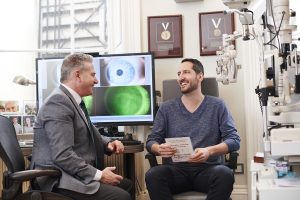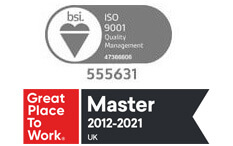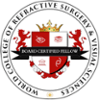Common Questions About Laser Eye Surgery and Suitability

Laser Eye Surgery has come a long way over the years, with surgeons – with the help of cutting-edge technology – now able to treat more patients and higher prescriptions than ever before. But it is still important to be aware of any factors that may affect your suitability for Laser Eye Surgery treatment. In this article, we’re taking a look at some of the most common questions about Laser Eye Surgery and suitability.
What is Myopia (Short-Sightedness)?
Myopia – more commonly known as short-sightedness or near-sightedness – is the most common refractive error, affecting over a quarter of the global population.
Myopia occurs when the eyeball grows too long (from the front to the back) or when the cornea (the clear front layer of the eye) or the lens is abnormally shaped. These features affect how light is reflected into the eye causing it to be focused in front of the retina instead of on it. As a result, objects that are far away appear blurry.
For more information about Myopia and how Laser Eye Surgery could help, click here.
What is Astigmatism?
In fully functional and healthy eyes, the cornea is sphere-shaped – like a football. However, in patients with astigmatism, the cornea is oval-shaped – more like a rugby ball. This difference can cause images to appear blurred or “ghost-like” as light rays entering the eye are refracted unequally.
Astigmatism can co-occur with other refractive errors with many people with myopia also having some degree of astigmatism.
To learn more about Astigmatism and how Laser Eye Surgery could help, click here.
What is a Prescription?
Glasses and contact lenses have been around for a long time with the primary aim of correcting your refractive error. However, the most important factor in achieving effective correction is the accurate measurement of your prescription.
Optometrists and ophthalmologists measure refractive errors like myopia, hyperopia and astigmatism in units called dioptres. These measurements indicate the amount of correction you need to see normally. For example, one dioptre is the equivalent of a lens that can focus on an object one metre away.
Either a plus (+) or minus (-) sign before the value determines whether the patient is long- or short-sighted, respectively. A typical prescription indicates the extent of refractive error (-5.00 indicates short-sightedness), the degree of astigmatism (e.g., -.150), and the axis of astigmatism (e.g., “180” indicates astigmatism in a horizontal direction). This prescription would read -5.00 / -1.50 x 180.
The table below illustrates the ranges from mild to severe short-sightedness and mild to severe long-sightedness:
| Mild short-sightedness | Myopia up to -3.00 dioptres |
| Low short-sightedness | Myopia up to -3.25 to 6.00 dioptres |
| Moderate short-sightedness | Myopia from -6.25 to -11.00 dioptres |
| Severe short-sightedness | Myopia from -11.25 to -23.50 dioptres |
| Low long-sightedness | Hyperopia from +0.75 to +2.50 dioptres |
| Moderate long-sightedness | Hyperopia from +2.75 to +6.00 dioptres |
| Severe long-sightedness | Hyperopia from +6.25 to +12.00 dioptres |
To learn more about how your prescription is measured, click here.
What is 20/20 or 6/6 vision?
In the most common visual acuity test, known as the Snellen test, the optometrist places an eye chart at a distance of 20 feet (or 6 metres, depending on the customary unit of measurement).
In the most common visual acuity test, an optometrist begins by placing an eye chart at a standard distance of twenty feet, or six metres away from you, depending on the customary unit of measure.
Each line features letters of a different size, with letters at the bottom of the chart being the smallest. The term “20/20” or “6/6” simply indicates that a person can read at 20 feet what a person with normal acuity could read at that distance. In simple terms, this means that you have average visual acuity.
The limit for driving in the UK is 20/40, which means you can see at 20 feet what a person with normal visual acuity can see at 40 feet. But it is also possible to see better than “the norm”.
To learn more about 20/20 vision and how your visual acuity is measured, click here.
Why can London Vision Clinic treat higher Prescriptions than the norm?
Generally speaking, the higher the prescription, the more difficult it is to correct with Laser Eye Surgery. Achieving satisfactory outcomes in patients with higher prescriptions requires more experienced surgeons and the most up-to-date technology. Luckily, here at London Vision Clinic, we have both in abundance!
At our Harley Street clinic, we conduct the most comprehensive screening possible, including testing under extreme conditions (i.e., full darkness pupillometry, reduced light contrast sensitivity testing, dilated refractions, etc). This allows us to collect the most detailed data about your eyes and prescription that we can then use to create your bespoke treatment plan.
Accuracy decreases as operative prescription increases, so many clinics may want to keep their results high by treating simpler prescriptions. Due to our expertise and technology, our results exceed the standard among all prescriptions.
To learn more about how we treat higher prescriptions at London Vision Clinic and to watch expert Laser Eye Surgeon Mr Glenn Carp discuss this in more detail, click here.
Do the results of Laser Eye Surgery differ between prescriptions?
In general, higher prescriptions are harder to treat than lower prescriptions. As a result, you will generally find that a clinic’s results decrease as prescriptions increase.
Our results at London Vision Clinic also mirror this trend, although not to the same extent as the norm. Therefore, when reviewing a clinic’s outcomes, it is crucial to compare like with like – that is, consider their results for prescription similar to your own. Unfortunately, this can sometimes be difficult as many providers advertise overall results across all prescriptions. This makes the results less relevant as they are often biased towards lower prescriptions.
As we mentioned, at London Vision Clinic, we can successfully treat higher prescriptions than the norm. We achieve this by offering high-profile Treatments to our patients with higher prescriptions. This essentially gives us two attempts to reach the desired outcome as the treatment is planned in two stages enabling us to optimise safety and results for patients with higher prescriptions.
For more information about our results in treating higher prescriptions and to watch a video on this topic, click here.
Is there a greater chance of needing an enhancement if you have a higher prescription?
As mentioned above, it is more difficult to achieve optimum results in patients with higher prescriptions. Because of this, the need for enhancement procedures is generally higher in these patients.
We find that enhancements are more typical among patients with higher pre-operative prescriptions as well as among those with long-sighted prescriptions. Nonetheless, our enhancement rates remain relatively low (between 5 and 8 per cent!). Furthermore, we include an enhancement procedure in the cost of treatment for patients whom we think would benefit.
For more information about when an enhancement procedure might be needed, click here.
Are Laser Eye Surgery prices higher for higher prescriptions?
Some clinics increase their fees for the treatment of higher prescriptions while others will turn away patients with higher prescriptions altogether. This may be because the clinic in question lacks the expertise and/or technology needed to treat higher prescriptions, or because higher prescriptions have a higher likelihood of requiring an enhancement procedure.
While these clinics may reflect this higher risk of an enhancement procedure into the initial cost at the outset (whether it will be needed or not), we take a different approach.
Our approach at London Vision Clinic is to offer patients with higher prescriptions the option of planned high-profile treatments. We have found that high-profile treatments have a higher likelihood of reaching the targets we set out for the patient from the outset, meaning they’re also a safer way to treat higher prescriptions.
High-profile procedures cost more in terms of time and money, but the vast majority of our patients, when presented with this option, decide it is best for them.
Learn more about the cost of treating higher prescriptions and watch expert surgeon Mr Glenn Carp answer this question.
Are there more risks associated with treating higher prescriptions?
While Laser Eye Surgery has become increasingly safe and effective since its invention in the late 1980s (it is among the safest elective procedures in the world!), it does come with a small risk of side effects. In the vast majority of cases, these side effects are minor and easily managed; however, higher prescriptions can be associated with a higher risk of night vision disturbances and corneal haze.
Night vision disturbances
Over the years, our founder and expert Laser Eye Surgeon Professor Dan Reinstein has contributed significantly to the advancement of Laser Eye Surgery techniques and technology. One of his key focuses in this time has been the correction (and prevention) of night vision disturbances (halos and starbursts). Prof. Reinstein has helped to develop key protocols for the correction and prevention of night vision disturbances – even when treating very high prescriptions and patients with large pupils.
At Lonon Vision Clinic, we have access to the world’s most advanced Laser Eye Surgery technology. This includes the Carl Zeiss Meditec MEL 80 excimer laser system. It is therefore extremely rare for patients to end up with night vision disturbances. We confidently believe that we have the most sophisticated systems in place for preventing or treating night vision disturbances.
Corneal haze
Corneal haze is extremely unusual following LASIK treatment. In corneal surface procedures such as PRK/LASEK, however, the risk of haze increases with the prescription. Other factors that may affect the risk of corneal haze include the smoothness of the surface created by the laser as well as the protocols for postoperative management of the cornea.
Corneal haze is part of the normal healing process of PRK/LASEK and gradually subsides with little or no permanent effect on vision. If the haze is excessive or does not go away, the patient may need additional treatment either with medications to reduce the haze, further laser surgery to physically remove the haze, or both.
Astigmatism
Patients with very high prescriptions also have a higher risk of developing astigmatism after Laser Eye Surgery. This occurs in roughly three in every 1,000 cases. Contact lenses can usually correct this form of astigmatism (glasses will not). Astigmatism can occur even if the surgery goes perfectly; however, an inexperienced surgeon or one who does not use the best equipment increases this risk.
To learn more about the risks associated with treating higher prescriptions, click here.
Can Laser Eye Surgery treat the loss of reading vision?
As we get older, our eye’s ability to focus on near objects begins to deteriorate. This can significantly affect our reading vision and ability to perform close tasks. This deterioration is known as presbyopia or ‘ageing eyes’.
Unlike many Laser Eye Surgery clinics, we have been treating patients with presbyopia for years.
The technique used to correct presbyopia is known as PRESBYOND® Laser Blended Vision. With this technique, one eye is treated to view objects mainly at a distance, but a little up close, and the other is treated to view objects mainly up close, but a little at a distance.
The brain is able to combine these two images, enabling the individual to see clearly at both distance and up close without effort. In most cases, the brain can compensate and you’ll experience an excellent depth of focus and overall visual acuity, without the need to wear glasses or contact lenses.
To watch Mr Glenn Carp discuss this treatment in more detail, click here.
What conditions might make one unsuitable for Laser Eye Surgery?
Our team of expert Laser Eye Surgeons are well equipped to perform Laser Eye Surgery on a wider range of patients than almost anywhere else in the world. However, there are unfortunately still some patients we are unable to treat.
Some conditions – both affecting the eyes and your wider health – can affect your suitability for Laser Eye Surgery. Such conditions may include keratoconus and uncontrolled diabetes.
This can come as a disappointment to some patients who are extremely motivated to have their vision corrected. Fortunately though, for some, certain conditions are only a temporary barrier, and with our help, some of these patients do eventually qualify.
Furthermore, it is recommended that patients who are pregnant, breastfeeding, or are below the age of 18 do not undergo surgery as all of these factors can affect the stability of your prescription. Again, however, it is highly likely you will be suitable for treatment at a later date.
If you have or think you have a condition that could affect your suitability, simply tell your Patient Care Coordinator during your first phone call.
To learn about the conditions which might make you unsuitable for Laser Eye Surgery, click here.
What are the suitability differences between LASIK, LASEK, and PRK?
The vast majority of patients undergoing Laser Eye Surgery worldwide are suitable for LASIK. Today, only around 10% of patients receive LASEK or PRK surgery. The main factors that are taken into consideration when determining your suitability for LASIK, PRK, or LASEK are corneal thickness and the pre-operative prescription.
In recent years, we have also been able to offer a new, innovative treatment that is suitable for patients with thinner corneas. ReLEx SMILE is a keyhole procedure that has helped to make Laser Eye Surgery an option for more patients than ever before.
To learn more about the suitability differences between these procedures, click here.
If you have any further questions relating to Laser Eye Surgery and your suitability (or any of our other treatments), don’t hesitate to get in touch with one of our friendly clinic coordinators. Alternatively, Book a Consultation to start your journey to clear vision today.


